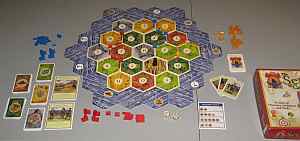Become One of the Settlers of Catan
Welcome to the 3rd in a series of reviews of 10 of my favorite board games. Today I go back to the game that started it all, the game that got me hooked on board gaming as a major hobby, time sink, and money grabber (and I mean that in a good way), the game called The Settlers of Catan.
 The Settlers of Catan was published in 1995, but didn’t make my acquaintance until 2006. I guess it’s a little unusual that I don’t actually own the game. There’s a copy of it on our shelves that belongs to a friend who has left it with me indefinitely. We don’t break it out as often as we used to, but it’s still a lot of fun when we do.
The Settlers of Catan was published in 1995, but didn’t make my acquaintance until 2006. I guess it’s a little unusual that I don’t actually own the game. There’s a copy of it on our shelves that belongs to a friend who has left it with me indefinitely. We don’t break it out as often as we used to, but it’s still a lot of fun when we do.
One of the main features of Settlers is the modular board. It’s made of large hexagonal tiles that are arranged differently (randomly) every game. The base game is played with 3 or 4 players, but I highly recommend that you get the 5-6 player expansion as soon as you get the original.
Your goal in Settlers is to accumulate 10 victory points by building roads, settlements and cities (think houses and hotels in Monopoly), and armies, by having the longest road and largest army, and by collecting victory point cards.
To acquire those items, you need resources in the form of cards showing either wood, grain, brick, sheep, or stone. You get these chiefly by strategic placement of your houses and hotels and by trading cards with other players.
With the advent and popularity of social media (Facebook, Twitter, et al), it seems to me now that The Settlers of Catan is also so popular because it is a social game. The trading aspect of Settlers gives it the interactivity that so many young people (teens, college students) really enjoy.
The original Settlers isn’t the only kid on the block anymore. Since 1995, several more Catan games have been published:
- Cities & Knights
- Seafarers
- Starfarers
- Starship
- Elasund
- Traders & Barbarians
- Kids of Catan
- and more….
Try one or more of these games with your friends soon.
Check the price of The Settlers of Catan on Amazon.

Pingback:Trivial Pursuit - The Pre-Euro Era